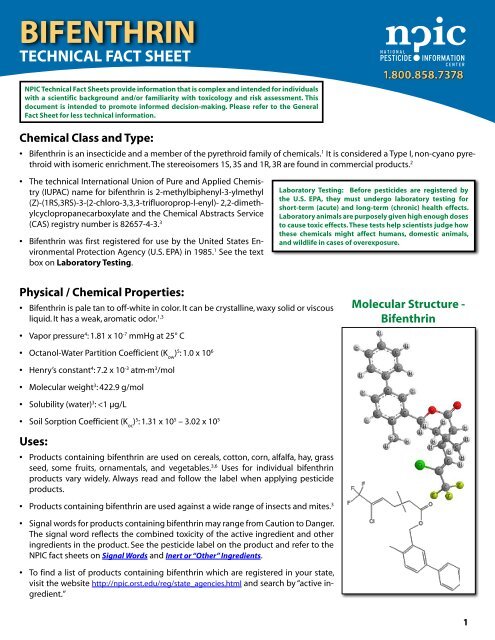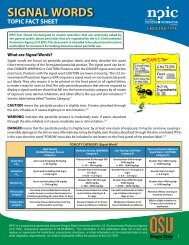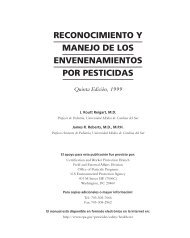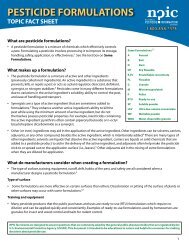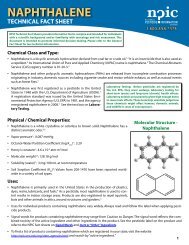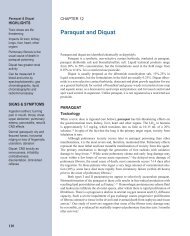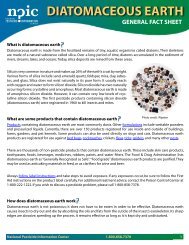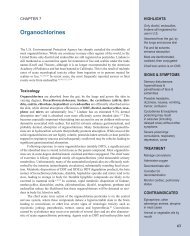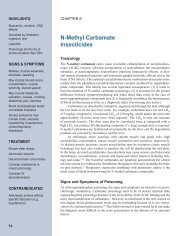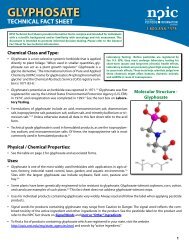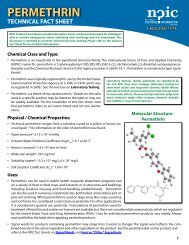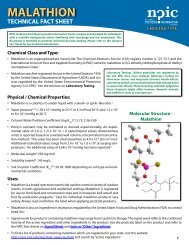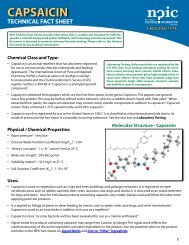BIFENTHRIN - National Pesticide Information Center - Oregon State ...
BIFENTHRIN - National Pesticide Information Center - Oregon State ...
BIFENTHRIN - National Pesticide Information Center - Oregon State ...
You also want an ePaper? Increase the reach of your titles
YUMPU automatically turns print PDFs into web optimized ePapers that Google loves.
<strong>BIFENTHRIN</strong><br />
TECHNICAL FACT SHEET<br />
NPIC Technical Fact Sheets provide information that is complex and intended for individuals<br />
with a scientific background and/or familiarity with toxicology and risk assessment. This<br />
document is intended to promote informed decision-making. Please refer to the General<br />
Fact Sheet for less technical information.<br />
Chemical Class and Type:<br />
1<br />
••<br />
Bifenthrin is an insecticide and a member of the pyrethroid family of chemicals. It is considered a Type I, non-cyano pyrethroid<br />
with isomeric enrichment. The stereoisomers 1S, 3S and 1R, 3R are found in commercial products. 2<br />
•• The technical International Union of Pure and Applied Chemistry<br />
(IUPAC) name for bifenthrin is 2-methylbiphenyl-3-ylmethyl<br />
(Z)-(1RS,3RS)-3-(2-chloro-3,3,3-trifluoroprop-l-enyl)- 2,2-dimethylcyclopropanecarboxylate<br />
and the Chemical Abstracts Service<br />
(CAS) registry number is 82657-4-3. 3<br />
•• Bifenthrin was first registered for use by the United <strong>State</strong>s Environmental<br />
Protection Agency (U.S. EPA) in 1985. 1 See the text<br />
box on Laboratory Testing.<br />
Laboratory Testing: Before pesticides are registered by<br />
the U.S. EPA, they must undergo laboratory testing for<br />
short-term (acute) and long-term (chronic) health effects.<br />
Laboratory animals are purposely given high enough doses<br />
to cause toxic effects. These tests help scientists judge how<br />
these chemicals might affect humans, domestic animals,<br />
and wildlife in cases of overexposure.<br />
Physical / Chemical Properties:<br />
•• Bifenthrin is pale tan to off-white in color. It can be crystalline, waxy solid or viscous<br />
liquid. It has a weak, aromatic odor. 1,3<br />
••<br />
Vapor pressure 4<br />
: 1.81 x 10 -7 mmHg at 25° C<br />
Molecular Structure -<br />
Bifenthrin<br />
••<br />
Octanol-Water Partition Coefficient (Kow )5 : 1.0 x 10 6<br />
••<br />
Henry’s constant 4<br />
: 7.2 x 10 -3 atm·m 3 /mol<br />
••<br />
Molecular weight 3<br />
: 422.9 g/mol<br />
••<br />
Solubility (water) 3<br />
:
<strong>BIFENTHRIN</strong><br />
TECHNICAL FACT SHEET<br />
Mode of Action:<br />
Target Organisms<br />
• Bifenthrin is designed to be effective by contact or ingestion.<br />
•<br />
3<br />
•• Bifenthrin is a Type I pyrethroid that affects the central and peripheral nervous system by interfering with sodium channel<br />
gating. Pyrethroids delay the closure of the sodium channel. Type I pyrethroids such as bifenthrin tend to hold the channel<br />
open for shorter times compared to type II pyrethroids. 7<br />
Non-target Organisms<br />
• The mechanism of action of pyrethroids, including bifenthrin, is the same for mammals and invertebrates.<br />
•<br />
7<br />
••<br />
Pyrethroids are less toxic to mammals compared to insects because of mammals’ higher body temperature, larger body<br />
size, and lower sensitivity of the ion channel sites. 7<br />
•• Pyrethroids other than bifenthrin have shown that they may affect fish and gill-breathing aquatic insects by inhibiting ATP.<br />
This disrupts ionic balances and osmoregulation making these organisms more susceptible to the toxic effects of pyrethroids.<br />
8,9,10<br />
Acute Toxicity:<br />
Oral<br />
•• Bifenthrin is highly toxic to mice when ingested, with an acute<br />
oral LD 50<br />
of 43 mg/kg. 11 See the text boxes on Toxicity Classification<br />
and LD 50<br />
/LC 50<br />
.<br />
•• Bifenthrin is moderately toxic to rats when ingested, with an<br />
acute oral LD 50<br />
ranging from 53.4 mg/kg to 210.4 mg/kg. 12<br />
•• Bifenthrin was fed to rats at doses of 10, 35 or 75 mg/kg. Signs of<br />
toxicity were only observed at the highest dose tested and occurred<br />
within 6-8 hours. Observed signs included tremors, clonic<br />
convulsions, twitching, incoordination, staggered gait, splayed<br />
hind limbs, atypical posture and abdominogenital staining. 13<br />
•• In another study, researchers fed bifenthrin to male rats in doses of up to 20 or 26 mg/kg, which were given in volumes of<br />
either 1 or 5 mL/kg. The researchers used corn oil as the vehicle to test how dose volumes affected bifenthrin neurotoxicity.<br />
Observed signs were more severe at the 1 mL/kg than 5 mL/kg delivery volume and this difference was most evident 4<br />
hours after dosing. The rats exhibited fine tremors, increased head shaking, pawing, elevated body temperature, increased<br />
click response, and decreased grip strength and motor activity. Within 24-48 hours after dosing, the rats were reported to<br />
have fully recovered. 14<br />
Dermal<br />
• Bifenthrin is low in toxicity when applied to the skin of rats and rabbits. The acute dermal LD<br />
kg after a 24 hour exposure to bifenthrin. 3<br />
•<br />
50<br />
was greater than 2000 mg/<br />
3<br />
••<br />
Bifenthrin was non-irritating when applied to the skin of rabbits and practically non-irritating to the eyes of rabbits.<br />
•• Bifenthrin did not cause skin sensitization when applied to the skin of guinea pigs according to the Buehler method. When<br />
bifenthrin was administered to guinea pigs according to the maximization method, skin sensitization occurred. 12<br />
Inhalation<br />
• Bifenthrin is low in toxicity to rats when inhaled, with an acute inhalation LD<br />
•<br />
50<br />
LD 50<br />
/LC 50<br />
: A common measure of acute toxicity is the lethal<br />
dose (LD 50<br />
) or lethal concentration (LC 50<br />
) that causes death<br />
(resulting from a single or limited exposure) in 50 percent<br />
of the treated animals. LD 50<br />
is generally expressed as the<br />
dose in milligrams (mg) of chemical per kilogram (kg) of<br />
body weight. LC 50<br />
is often expressed as mg of chemical<br />
per volume (e.g., liter (L)) of medium (i.e., air or water) the<br />
organism is exposed to. Chemicals are considered highly<br />
toxic when the LD 50<br />
/LC 50<br />
is small and practically non-toxic<br />
when the value is large. However, the LD 50<br />
/LC 50<br />
does not<br />
reflect any effects from long-term exposure (i.e., cancer,<br />
birth defects or reproductive toxicity) that may occur at<br />
levels below those that cause death.<br />
ranging from 0.8 mg/L to 1.10 mg/L.12<br />
2
<strong>BIFENTHRIN</strong><br />
TECHNICAL FACT SHEET<br />
Acute Oral<br />
LD 50<br />
Inhalation<br />
LC 50<br />
Dermal LD 50<br />
Primary Eye<br />
Irritation<br />
Primary Skin<br />
Irritation<br />
TOXICITY CLASSIFICATION - <strong>BIFENTHRIN</strong><br />
High Toxicity Moderate Toxicity Low Toxicity Very Low Toxicity<br />
Up to and including 50 mg/kg<br />
(≤ 50 mg/kg)<br />
Up to and including 0.05 mg/L<br />
(≤ 0.05 mg/L)<br />
(aerosol)<br />
Up to and including 200 mg/kg<br />
(≤ 200 mg/kg)<br />
Corrosive (irreversible destruction of<br />
ocular tissue) or corneal involvement or<br />
irritation persisting for more than 21 days<br />
Corrosive (tissue destruction into the<br />
dermis and/or scarring)<br />
Greater than 50 through 500<br />
mg/kg<br />
(> 50 – 500 mg/kg)<br />
Greater than 0.05 through<br />
0.5 mg/L<br />
(>0.05 – 0.5 mg/L)<br />
Greater than 200 through<br />
2000 mg/kg<br />
(> 200 - 2000 mg/kg)<br />
Corneal involvement or other<br />
eye irritation clearing in 8 –<br />
21 days<br />
Severe irritation at 72 hours<br />
(severe erythema or edema)<br />
Greater than 500 through<br />
5000 mg/kg<br />
(> 500 – 5000 mg/kg)<br />
Greater than 0.5 through 2.0<br />
mg/L<br />
(> 0.5 – 2.0 mg/L)<br />
Greater than 2000 through<br />
5000 mg/kg<br />
(>2000 – 5000 mg/kg)<br />
Corneal involvement or other<br />
eye irritation clearing in 7<br />
days or less<br />
Moderate irritation at 72<br />
hours (moderate erythema)<br />
Signs of Toxicity - Animals<br />
•• Signs of exposure in rats included tremors, twitching, clonic convulsions, atypical posture, incoordination and staggering<br />
gait. 15 Head shaking, pawing, and decreased grip strength have also been observed. 14<br />
•• Veterinary observations of acute exposures in cats and dogs to pyrethroids indicated that signs start with hyper-excitability<br />
followed by incoordination, diarrhea, depression, and dilated pupils. Some cases reported additional signs such as<br />
chewing, head bobbing, paresis, and whole-body tremors. 2<br />
•• Clinical signs reported after pets were exposed to pyrethroids include single-episode vomiting or diarrhea, reduced activity,<br />
twitching of the ear, paw flicking and hypersalivation. These signs are typically self-limiting and considered minor. 16<br />
Signs of Toxicity - Humans<br />
•• Paresthesia was the most commonly reported symptom from dermal exposure in occupational studies involving pyrethroids.<br />
Skin sensations were characterized as tingling, itching, burning, and numbness of the skin after dermal exposure.<br />
The paresthesia was reported to be temporary and reversible in a period of hours, sometimes lasting up to 48 hours. 15<br />
15<br />
••<br />
Paresthesia is typically reported only at the site of dermal exposure and is not associated with systemic intoxication.<br />
7<br />
••<br />
Respiratory and nasal irritation may be caused by the inhalation of aerosol droplets or dust of pyrethroids.<br />
Greater than 5000 mg/kg<br />
(> 5000 mg/kg)<br />
Greater than 2.0 mg/L<br />
(> 2.0 mg/L)<br />
(dust)<br />
Greater than 5000 mg/kg<br />
(> 5000 mg/kg)<br />
Minimal effects clearing in<br />
less than 24 hours<br />
Mild or slight irritation at<br />
72 hours (no irritation or<br />
erythema)<br />
The highlighted boxes reflect the values in the “Acute Toxicity” section of this fact sheet. Modeled after the U.S. EPA, Office of <strong>Pesticide</strong><br />
Programs, Label Review Manual, Chapter 7: Precautionary Labeling. http://www.epa.gov/oppfead1/labeling/lrm/hap-07.pdf<br />
•• Ingestion of pyrethroids may cause a sore throat, nausea, abdominal pain and vomiting almost immediately after ingestion.<br />
Other reported symptoms included increased oral secretions, ulcerations in the mouth, difficulty swallowing, headache,<br />
dizziness and fatigue. Symptoms less frequently reported include blurred vision, heart palpitations and tightness in<br />
the chest. 7<br />
•• Always follow label instructions and take steps to avoid exposure. If any exposures occur, be sure to follow the First Aid instructions<br />
on the product label carefully. For additional treatment advice, contact the Poison Control <strong>Center</strong> at 1-800-222-<br />
1222. If you wish to discuss an incident with the <strong>National</strong> <strong>Pesticide</strong> <strong>Information</strong> <strong>Center</strong>, please call 1-800-858-7378.<br />
3
<strong>BIFENTHRIN</strong><br />
TECHNICAL FACT SHEET<br />
Chronic Toxicity:<br />
Animals<br />
•• Researchers fed rats technical-grade bifenthrin for a minimum of 90<br />
days at doses of 0, 12, 50, 100, or 200 ppm. The NOAEL was 5 mg/kg/<br />
day (100 ppm) due to tremors observed in all animals at 200 ppm. 17<br />
See the text box on NOAEL, NOEL, LOAEL, and LOEL.<br />
•• Technical-grade bifenthrin (88.4% purity) was fed to dogs daily for<br />
13 weeks at doses of 0, 2.5, 5.0, 10.0, or 20.0 mg/kg. The NOAEL was<br />
established at 2.5 mg/kg due to tremors observed in animals dosed<br />
at 5.0 mg/kg and above. 18<br />
NOAEL: No Observable Adverse Effect Level<br />
NOEL: No Observed Effect Level<br />
LOAEL: Lowest Observable Adverse Effect Level<br />
LOEL: Lowest Observed Effect Level<br />
•• Researchers applied technical-grade bifenthrin to the shaved skin of rabbits for at least 6 hours per day for 21 days at doses<br />
of 0, 25, 50, 100, or 500 mg/kg. The NOAEL was established at 100 mg/kg due to loss of muscle control and tremors at the<br />
highest dose. 18<br />
Humans<br />
•• No human data were found on chronic effects of bifenthrin.<br />
Endocrine Disruption:<br />
••<br />
In one study, researchers observed differences in the estrogenic potential of two bifenthrin enantiomers, 1S-cis-bifenthrin<br />
and 1R-cis-bifenthrin. Using the in vitro human breast carcinoma MCF-7 cell proliferation assay, the relative proliferative effect<br />
ratios were 20.9% for 1R-cis-bifenthrin and 74.2% for 1S-cis-bifenthrin. 19<br />
••<br />
In the same study, Japanese medaka ( Oryzias latipes) were exposed to 1S-cis-bifenthrin or 1R-cis-bifenthrin at 10 ng/mL for<br />
10 days to measure the induction of vitellogenin. Both bifenthrin isomers induced vitellogenin, which is involved in egg<br />
production. Average levels of vitellogenin for fish exposed to the 1R-cis-bifenthrin were measured at 12.45 ng/mg, while<br />
those exposed to1S-cis-bifenthrin measured levels of vitellogenin at 1532 ng/mg. 19<br />
•• Bifenthrin is included in the draft list of initial chemicals for screening under the U.S. EPA Endocrine Disruptor Screening<br />
Program (EDSP). The list of chemicals was generated based on exposure potential, not based on whether the pesticide is a<br />
known or likely potential cause of endocrine effects. 20<br />
••<br />
No data were found on endocrine disruption effects of bifenthrin in humans.<br />
Carcinogenicity:<br />
Animals<br />
•• Researchers fed mice technical-grade bifenthrin for at least 20 months at doses of 0, 50, 200, 500, or 600 ppm. They observed<br />
an increased prevalence of liver carcinoma, adenoma, and/or hyperplasia in some male rats at 200, 500 and 600 ppm. 21<br />
•• In the same study, researchers observed an increased rate of sub-mucosal tumors in the bladder in males at the highest<br />
dose. A statistical analysis of these data conducted by reviewers found that the results “do not provide persuasive evidence<br />
of a compound-related effect.” Lesions of the type found in the mice have not been reported in humans. 21,22<br />
••<br />
Bifenthrin did not show any potential to cause tumors when rats were fed concentrations of 0, 12, 50, 100, or 200 ppm of<br />
technical bifenthrin for 2 years. 23<br />
••<br />
No mutagenic properties were observed in mutagenicity assays including the Ames test, in vivo rat bone marrow cells,<br />
Chinese hamster ovary (CHO) cells, and unscheduled DNA synthesis (UDS) at concentrations of bifenthrin up to 2.5 μl/mL. 1<br />
However, bifenthrin showed mutagenic properties in a mouse lymphoma assay. 1<br />
4
<strong>BIFENTHRIN</strong><br />
TECHNICAL FACT SHEET<br />
Humans<br />
•• The U.S. EPA classified bifenthrin as a Category C, possible human carcinogen. This rating is based on an increased rate of<br />
urinary bladder tumors in mice, adenoma and adenocarcinoma of the liver in male mice, and bronchioalveolar adenomas<br />
and adenocarcinomas of the lung in some female mice. 24 See the text box on Cancer.<br />
••<br />
No human data were found on carcinogenic effects of bifenthrin.<br />
Cancer: Government agencies in the United <strong>State</strong>s and abroad have developed programs to evaluate the<br />
potential for a chemical to cause cancer. Testing guidelines and classification systems vary. To learn more<br />
about the meaning of various cancer classification descriptors listed in this fact sheet, please visit the<br />
appropriate reference, or call NPIC.<br />
Reproductive or Teratogenic Effects:<br />
Animals<br />
•• Researchers fed rats technical grade bifenthrin at concentrations of 0, 30, 60, or 100 ppm for 2 generations. On days 7 and<br />
14 of the lactation period, females of the first generation showed reduced body weight gain. No effects on the litter size,<br />
litter weight, survival of the pups, or reproductive performance were noted. The NOAEL was established at 3 mg/kg/day (60<br />
ppm/day) due to tremors in the lactating dams of both generations at the highest dose. 18 See the text box on Cancer.<br />
•• Rats were orally administered bifenthrin at doses of 0, 0.5, 1.0, or 2.0 mg/kg on days 6 through 15 of gestation. No treatmentrelated<br />
reproductive effects occurred. At the highest dose, tremors were observed in the mother rats, but no treatmentrelated<br />
effects were noted in the embryos or fetuses. 18<br />
•• In a teratogenicity study, rabbits were fed bifenthrin at doses of 0, 2.7, 4.0, or 8.0 mg/kg on days 7 through 19 of gestation.<br />
No indications for the potential of birth defects were observed. The NOAEL for maternal toxicity was 2.7 mg/kg/day due to<br />
head and forelimb twitching at higher doses tested. No treatment-related effects were noted in the embryos or fetuses at<br />
the highest dose tested. 18<br />
Humans<br />
•• No human data were found on the teratogenic or reproductive effects of bifenthrin.<br />
Fate in the Body:<br />
Absorption<br />
7<br />
••<br />
In general, pyrethroids are poorly absorbed through the skin of humans.<br />
•• Rats were treated dermally with 36 μg bifenthrin. The bifenthrin was left on the shaved skin for 24 hours, and then washed<br />
away. Less than 4% was excreted in the urine or feces within 24 hours of treatment, indicating that dermal absorption is<br />
low. 25<br />
••<br />
In a study observing in vitro dermal absorption, radio-labeled bifenthrin in acetone was applied to dermatomed skin from<br />
human cadavers. When the skin was washed with soap and water 24 hours into the exposure, 71-83% of the applied dose<br />
was removed. 26<br />
24<br />
••<br />
Bifenthrin was absorbed slowly from the gastrointestinal tract of rats with an absorption half-life of 1.5 hours.<br />
Distribution<br />
•• When rats were fed one dose of 5 mg/kg of bifenthrin, they had low residues in their tissues. The highest residues were<br />
found in fat (up to 1.7 ppm), skin (up to 0.4 ppm) and liver (up to 0.1 ppm). Other tissues tested contained residues of less<br />
than 0.1 ppm. 18<br />
5
<strong>BIFENTHRIN</strong><br />
TECHNICAL FACT SHEET<br />
•• Bifenthrin was fed to female rats for 70 days at 0.5 mg/kg/day. The highest residue concentrations averaged 9.6 ppm and<br />
were found in fat. Residues consisted of 65%-85% bifenthrin. Three unspecified metabolites made up the rest. Residues<br />
were also detected in the sciatic nerve (3.2 ppm), skin (1.7 ppm), ovaries (1.7 ppm), liver (0.4 ppm), kidney (0.3 ppm), blood<br />
(0.06 ppm), and plasma (0.06 ppm). 27<br />
Metabolism<br />
•• Metabolism of bifenthrin in rats mainly occurs by hydrolysis of the ester linkage and oxidation of the resultant alcohol to<br />
the acid. 24 Pyrethroids, such as bifenthrin, are rapidly metabolized in the liver to a number of metabolites. Metabolism can<br />
occur by hydrolysis of the ester linkage, oxidation of aromatic rings and methyl groups and by conjugation reactions. 7<br />
••<br />
In addition to the parent compound, major metabolites of bifenthrin detected in rat plasma were the hydrolysis product<br />
2-methyl-3-phenylbenzylalcohol, and the oxidation product 2-methly-3-phenylbenzoic acid (MPA). 28<br />
•• In a study where female rats were fed 0.5 mg/kg/day of bifenthrin for 70 days, clearance half-lives were estimated after dosing<br />
was discontinued. Half-lives were 51 days in fat, 50 days in skin, 40 days in the ovaries and sciatic nerve, 28 days in the<br />
kidney, and 19 days in the liver. 27<br />
Excretion<br />
•• In several studies, rats that were fed bifenthrin eliminated the majority of it within 72 hours in the urine (13%-25%) and<br />
feces (66%-83%), with little or no change in the original compound. 18,24<br />
••<br />
In another study, rats that ate one dose of 5 mg/kg excreted most of the bifenthrin in the urine (6%-7%) and feces (76%-<br />
79%) within 48 hours. Approximately 90% of the administered dose was eliminated within 7 days. 18<br />
•• In three studies involving lactating goats, researchers fed the goats 2 mg/kg/day for 7 days. Residues of unchanged bifenthrin<br />
were found in milk at concentrations ranging from 0.8 to 1.5 ppm. Bifenthrin accounted for 75%-98% of the residue<br />
found in the milk. 29,30,31<br />
••<br />
In one of the these studies, the metabolite biphenyl acid was found in goat liver and kidney at concentrations of 0.6 ppm<br />
(31%) and 0.2 ppm (42%) respectively and was also detected as a minor metabolite in milk. 30<br />
•• Laying hens were orally administered 40 ppm of bifenthrin for 10 days. Maximum bifenthrin residues were found in the<br />
egg whites at 0.04 ppm, egg yolks at 3 ppm, and in both the fat and liver at 2 ppm. Elimination was primarily through excreta.<br />
32<br />
Medical Tests and Monitoring:<br />
•• Biomarkers of human exposure to bifenthrin have been reported in the scientific literature. Scientists used HPLC-UV to<br />
detect and quantify bifenthrin and its primary metabolite 2-methyl-3-phenylbenzoic acid (MPA) in urine. 33 This method<br />
for evaluating exposure to bifenthrin and its metabolite has not been well-studied in humans, and its clinical significance<br />
is unknown.<br />
Environmental Fate:<br />
Soil<br />
5<br />
••<br />
The aerobic half-life of bifenthrin in soil ranges from 97-250 days, depending on soil type. See the text box on Half-life<br />
(page 7).<br />
5<br />
••<br />
The soil half-life of bifenthrin ranged from 106 to 147 days when the soil was exposed to sunlight.<br />
4<br />
••<br />
In field dissipation studies, bifenthrin half-lives ranged from 122 to 345 days in a variety of soils.<br />
6
<strong>BIFENTHRIN</strong><br />
TECHNICAL FACT SHEET<br />
•• Bifenthrin is immobile in soil containing high amounts of silt, clay,<br />
and organic matter and has low mobility in sandy soil containing<br />
small amounts of organic matter. 1<br />
•• In aerobic soil studies and flooded soil tests, breakdown of bifenthrin<br />
yielded minor degradation products in small quantities. The<br />
degradate with the highest concentration was 4’-hydroxy bifenthrin,<br />
which accounted for 3%-5.6% of the total amount applied. 34<br />
Water<br />
•• Bifenthrin has a low potential to contaminate ground water due to<br />
its tendency to bind to soil and its low water solubility. However,<br />
bifenthrin that is soil-bound has the potential to contaminate surface<br />
waters through runoff. 5<br />
•• Bifenthrin is considered photo-stable with aqueous photolysis halflives<br />
ranging from 276 to 416 days. 5<br />
The “half-life” is the time required for half of the<br />
compound to break down in the environemnt.<br />
1 half-life = 50% remaining<br />
2 half-lives = 25% remaining<br />
3 half-lives = 12% remaining<br />
4 half-lives = 6% remaining<br />
5 half-lives = 3% remaining<br />
Half-lives can vary widely based on environmental<br />
factors. The amount of chemical remaining after a<br />
half-life will always depend on the amount of the<br />
chemical originally applied. It should be noted that<br />
some chemicals may degrade into compounds of<br />
toxicological significance.<br />
••<br />
At 20° C, bifenthrin has an aerobic half-life in sediment ranging from 12 to 16 months. The half-life range was 25-65 months<br />
at 4° C. 35<br />
35<br />
••<br />
Under anaerobic conditions, bifenthrin has a half-life in sediment ranging from 8 to 16 months at 20° C and 4° C. After 30<br />
days of anaerobic conditions, the metabolite 4’-hydroxy bifenthrin accounted for 4.5% of the total amount of bifenthrin<br />
applied. 4<br />
5<br />
••<br />
Over a 30-day period, bifenthrin was stable to abiotic hydrolysis in 25° C water at pH 5, 7, and 9. Due to its tendency to<br />
tightly bind to soil particles, bifenthrin degradation can be inhibited in sediment. 5,35<br />
•• In a study that monitored pyrethroids in water and sediments from urban creeks near Sacramento, CA, bifenthrin was detected<br />
in 23 of 24 water samples. Over the course of 10 months, median concentrations of bifenthrin in water ranged from<br />
5 to 17 ng/L with a maximum concentration measured at 73 ng/L. 36<br />
••<br />
••<br />
Bifenthrin was detected in 94% of sediment samples in a study of residential stream sediments in central Texas. The mean<br />
concentration of bifenthrin was 0.74 µg/g organic content (OC), with a maximum concentration found at 2.9 µg/g OC. 37<br />
Of 14 creek sites sampled in Nashville, Tennessee, half detected only one pyrethroid in each sample, most at concentrations<br />
barely above detection. Five other sample sites did not detect pyrethroids above the 1 ng/g reporting limit. 38<br />
•• A study in California examined sediments in a mixed land use setting during the wet and dry seasons. Bifenthrin was detected<br />
at maximum concentrations of 122 µg/kg in dry season samples (n=19) and 542 µg/kg in the wet season samples<br />
(n=18). Bifenthrin was one of the most frequently detected pyrethroids and found in 95-100% of the samples. 39<br />
•• Several studies of urban creek sediments in California have detected bifenthrin in the sediment. In one study, bifenthrin<br />
was detected in all 30 samples collected in concentrations ranging from 2.19 to 219 ng/g dry weight. In another study of<br />
suspended sediment discharged from urban storm water drains, bifenthrin was detected at concentrations ranging from<br />
252 to 1211 ng/g dry weight. 36,40<br />
Air<br />
-7<br />
••<br />
Bifenthrin has a low potential to volatilize after being applied to dry soil, based on its low vapor pressure (1.81 x 10 mmHg<br />
at 25° C) and Henry’s law constant (7.2 x 10 -3 atm·m 3 /mol). 5<br />
7
<strong>BIFENTHRIN</strong><br />
TECHNICAL FACT SHEET<br />
•• Bifenthrin’s physical properties suggest that it is unlikely to volatilize from soil. However, it is slightly more likely to volatilize<br />
when applied to wet soil compared to dry soil. Soil sorption may vary depending on soil types. 34,41<br />
Plants<br />
• Bifenthrin is not absorbed by foliage or translocated throughout plants.<br />
•<br />
1<br />
42<br />
••<br />
Bifenthrin was not metabolized in apples 21 days after the last of three applications.<br />
43<br />
••<br />
When used according to label directions, bifenthrin is considered non-toxic to plants.<br />
Indoor<br />
•• No data were found on the indoor fate of bifenthrin.<br />
Food Residue<br />
•• In 2007, the United <strong>State</strong>s Department of Agriculture (USDA) <strong>Pesticide</strong> Data Program (PDP) analyzed 9207 food commodity<br />
samples. Bifenthrin residues were found in 303 samples (0.3% of the samples tested). No residue exceeded EPA’s tolerance<br />
level. 44<br />
•• In the same study, 253 finished water samples and 250 untreated water samples were analyzed for bifenthrin. Of these, only<br />
one sample of untreated water had a residue above the level of detection of 8.0 ppt. 44<br />
Ecotoxicity Studies:<br />
Birds<br />
••<br />
Bifenthrin is low in toxicity to birds with acute oral LD values of 1800 mg/kg and less than 2150 mg/kg for bobwhite quail<br />
50<br />
(Colinus virginianus) and mallard ducks (Anas platyrhynchos), respectively. 1<br />
••<br />
Eight-day dietary LC values for bifenthrin were 1280 mg/kg and 4450 mg/kg for bobwhite quail and mallard ducks, respectively.<br />
50 3<br />
•• Bobwhite quail and Mallard ducks were fed bifenthrin at doses of 25, 50, and 75 ppm starting 12 weeks before the start of<br />
egg production and continuing over a 24-week period. Eggs were collected during weeks 13-24. No evidence of adverse<br />
effects on reproduction was observed. 12<br />
•• There are potential exposure risks for birds and mammals that feed on aquatic organisms based on the environmental<br />
persistence and the high bioconcentration factor of bifenthrin in fish. 5<br />
Fish and Aquatic Life<br />
••<br />
Bifenthrin is very highly toxic to fish with 96-hour LD values of 0.10 and 0.18 ppb for rainbow trout (Onchorynchus mykiss)<br />
50<br />
and bluegill sunfish (Lepomis macrochirus), respectively. 1<br />
••<br />
Bifenthrin can concentrate in fish tissues. Fathead minnows ( Pimephales promelas) exposed to 0.0037 µg/L bifenthrin had<br />
bioconcentration factors of 21,000 after 127 days and 28,000 after 254 days of exposure.. 45<br />
••<br />
In one study, detritus feeders known as gizzard shad ( Dorosoma cepedianum) were dosed with sediment-bound bifenthrin<br />
for eight days starting at concentrations of 0, 90, 185, 250, 1550, and 7750 ng/L. The eight-day LC 50<br />
values were 521 and 207<br />
ng/L, respectively, when fish were exposed to one-hour and average bifenthrin concentrations. Behavioral responses from<br />
concentrations greater than 185 ng/L presented as slow swimming, head-shaking, opercle flaring, and gulping for air near<br />
the water’s surface. 46<br />
•• The strong adsorption of bifenthrin to soil can limit its availability to certain aquatic organisms, mitigating toxicity. However,<br />
cladocerans and other detritus-feeding species can be affected by soil-bound bifenthrin. 5<br />
8
<strong>BIFENTHRIN</strong><br />
TECHNICAL FACT SHEET<br />
••<br />
Third-generation pyrethroids, including bifenthrin, were more toxic to Ceriodaphnia dubia and<br />
Daphnia magna compared with first-generation pyrethroids, with reported LC 50<br />
values of 0.07 ppb and 0.32 ppb,<br />
respectively. 5<br />
•• Bifenthrin is highly toxic to aquatic invertebrates. The 48-hour<br />
EC 50<br />
for Daphnia magna was 1.6 ppb and the 96-hour LC 50<br />
for<br />
Mysidopsis bahia was 3.97 ppt. 1 See the text box on EC 50<br />
.<br />
•• Researchers spiked sediment with bifenthrin and reported<br />
the mean 10-day LC 50<br />
for the amphipods Eohaustorius estuaries<br />
and Ampelisca abdita to be 0.008 and 0.948 mg/kg, respectively.<br />
47<br />
EC 50<br />
: The median effective concentration (EC 50<br />
) may be<br />
reported for sublethal or ambiguously lethal effects. This<br />
measure is used in tests involving species such as aquatic<br />
invertebrates where death may be difficult to determine.<br />
This term is also used if sublethal events are being<br />
monitored.<br />
Newman, M.C.; Unger, M.A. Fundamentals of Ecotoxicology; CRC Press, LLC.:<br />
Boca Raton, FL, 2003; p 178.<br />
•• In a sediment toxicity study, researchers found detectable levels ranging from 2.19 to 219 ng/g dry weight of bifenthrin in<br />
all 30 samples tested. All sediment samples were toxic to the amphipod Hyalella azteca, at 15° C. Several sediment samples<br />
included various combinations of other pyrethroids, piperonyl butoxide, organophosphates, and/or organochlorines. Researchers<br />
concluded that bifenthrin was one of the main contributors to sediment toxicity in this study. 40<br />
••<br />
Researchers collected sediment from three locations in California’s Central Valley and spiked it with bifenthrin. The average<br />
10-day LC 50<br />
reported for Hyalella azteca was 4.5 ng/g, with a range from 2.7 to 9.8 ng/g. 48<br />
5<br />
••<br />
Copepods, who depend on suspended organic matter, had mortality at a concentration of 0.90 ppb of bifenthrin.<br />
•• Researchers found a poor correlation between freely dissolved water concentrations and OC-based sediment concentrations<br />
of bifenthrin using solid-phase microextraction (SPME) method. They concluded that factors such as the characteristics<br />
of sediment organic matter and aging may significantly influence the bioavailability and toxicity of sediment-bound<br />
pyrethroids. 39<br />
Terrestrial Invertebrates<br />
•• Bifenthrin is very highly toxic to bees with a reported<br />
oral LD 50<br />
of 0.1μg/bee and contact LD 50<br />
of 0.01462 μg/<br />
bee. 3<br />
Regulatory Guidelines:<br />
•• The acute reference dose (RfD) for bifenthrin is 0.328<br />
mg/kg/day. 49 See the text box on Reference Dose.<br />
49<br />
••<br />
The chronic reference dose (RfD) for bifenthrin is 0.013 mg/kg/day.<br />
Reference Dose (RfD): The RfD is an estimate of the quantity of<br />
chemical that a person could be exposed to every day for the rest<br />
of their life with no appreciable risk of adverse health effects. The<br />
reference dose is typically measured in milligrams (mg) of chemical<br />
per kilogram (kg) of body weight per day.<br />
U.S. Environmental Protection Agency, Technology Transfer Network, Air Toxics Health<br />
Effects Glossary, 2009. http://www.epa.gov/ttnatw01/hlthef/hapglossaryrev.html#RfD<br />
•• The U.S. EPA classified bifenthrin as a Group C, possible human carcinogen, based on an increased rate of urinary bladder<br />
tumors in mice, adenoma and adenocarcinoma of the liver in male mice, and bronchioalveolar adenomas and adenocarcinomas<br />
of the lung in some female mice. 24 See the text box on Cancer (page 5).<br />
••<br />
••<br />
••<br />
The acute Population Adjusted Dose (aPAD) is 0.328 mg/kg/day based on a LOAEL of 70.3 mg/kg/day due to clinical observations<br />
and effects, differences in motor activity and mortality in rats. 49<br />
The chronic Population Adjusted Dose (cPAD) is 0.013 mg/kg/day based on a LOAEL of 2.7 mg/kg/day due to an increased<br />
incidence of tremors in a one-year oral toxicity study in dogs. 49 See the text box on Exposure (page 10).<br />
The aPAD and cPAD are equal to the acute and chronic RfD, which indicates no difference in toxicity between adults and<br />
children.<br />
18<br />
••<br />
The Acceptable Daily Intake (ADI) of bifenthrin for humans is 0.02 mg/kg.<br />
9
<strong>BIFENTHRIN</strong><br />
TECHNICAL FACT SHEET<br />
Exposure: Effects of bifenthrin on human health and the environment depend on how much<br />
bifenthrin is present and the length and frequency of exposure. Effects also depend on the<br />
health of a person and/or certain environmental factors.<br />
Date Reviewed: March 2011<br />
Please cite as: Johnson, M.; Luukinen, B.; Gervais, J.; Buhl, K.; Stone, D. 2010. Bifenthrin Technical Fact Sheet; <strong>National</strong> <strong>Pesticide</strong><br />
<strong>Information</strong> <strong>Center</strong>, <strong>Oregon</strong> <strong>State</strong> University Extension Services. http://npic.orst.edu/factsheets/biftech.pdf.<br />
References<br />
1. Bifenthrin <strong>Pesticide</strong> Fact Sheet; U.S. Environmental Protection Agency, Office of Prevention, <strong>Pesticide</strong>s, and Toxic Substances, Office of<br />
<strong>Pesticide</strong> Programs, U.S. Government Printing Office: Washington, DC, 1988.<br />
2. Wolansky, M. J.; Harrill, J. A. Neurobehavioral Toxicology of Pyrethroid Insecticides in Adult Animals: A Critical Review. Neurotoxicol.<br />
Teratol. 2008, 30 (2), 55-78.<br />
3. Tomlin, C. D. S. The <strong>Pesticide</strong> Manual, A World Compendium, 12 ed.; British Crop Protection Council: Surry, England, 2000; pp 502-504.<br />
4. Application for Experimental Use Permit, Product Chemistry. Unpublished DPR report number 50429-025, 1983, submitted to<br />
California Department of <strong>Pesticide</strong> Regulation by FMC Corporation. Environmental Fate of Bifenthrin; California Department of<br />
<strong>Pesticide</strong> Regulation, Environmental Monitoring and Pest Management Branch: Sacramento, CA, 1999.<br />
5. Fecko, A. Environmental Fate of Bifenthrin; California Environmental Protection Agency, Department of <strong>Pesticide</strong> Regulation,<br />
Environmental Monitoring and Pest Management Branch: Sacramento, CA, 1999.<br />
6. Toxicological Profile for Pyrethrins and Pyrethroids; U.S.Department of Health and Human Services, Agency for Toxic Substances<br />
and Disease Registry. http://atsdr.cdc.gov/toxprofiles/tp155.html (accessed Oct 2008), updated Apr 2004.<br />
7. Bradberry, S. M.; Cage, S. A.; Proudfoot, A. T.; Vale, J. A. Poisoning due to Pyrethroids. Toxicol. Rev. 2005, 24 (2), 93-106.<br />
8. Clark, J. M.; Matsumura, F. Two different types of inhibitory effects of pyrethroids on nerve Ca- and Ca + Mg-ATPase activity in the<br />
squid, Loligo pealei. Pestic. Biochem. Physiol. 1982, 18 (2), 180-190.<br />
9. Siegfried, B. Comparative Toxicity of Pyrethroid Insecticides to Terrestrial and Aquatic Insects. Environ. Toxicol. Chem. 1993, 12, 1683-<br />
1689.<br />
10. Coats, J. R.; Symonik, D. M.; Bradbury, S. P.; Dyer, S. D.; Timson, L. K.; Atchison, G. J. Toxicology of synthetic pyrethroids in aquatic<br />
organisms: An overview. Environ. Toxicol. Chem. 1989, 8 (8), 671-679.<br />
11. Freeman, C. Acute oral toxicity of FMC 54800 technical in mice. Unpublished report number A83-837, 1983, submitted to World<br />
Health Organization by FMC Corporation, Princeton, NJ. <strong>Pesticide</strong> Residues in Food - 1992: Toxicological Evaluations; International<br />
Programme on Chemical Safety, World Health Organization: Rome, 1992; pp. 79-101.<br />
12. FAO Specifications and Evaluations for Agricultural <strong>Pesticide</strong>s: Bifenthrin. Food and Agriculture Organization of the United Nations and<br />
World Health Organization: Rome, 2010; pp 1-33.<br />
13. Watt, B. FMC 54800 technical: acute neurotoxicity screen in rats. Unpublished report number A97-4643 submitted by FMC<br />
Corporation, 1998. Soderlund, D. M.; Clark, J. M.; Sheets, L. P.; Mullin, L. S.; Piccirillo, V. J.; Sargent, D.; Stevens, J. T.; Weiner, M. L.<br />
Mechanisms of pyrethroid neurotoxicity: implications for cumulative risk assessment. Toxicol. 2002, 171 (1), 3-59<br />
14. Wolansky, M. J.; McDaniel, K. L.; Moser, V. C.; Crofton, K. M. Influence of Dosing Volume on the Neurotoxicity of Bifenthrin. Neurotoxicol.<br />
Teratol. 2007, 29, 377-384.<br />
15. Soderlund, D. M.; Clark, J. M.; Sheets, L. P.; Mullin, L. S.; Piccirillo, V. J.; Sargent, D.; Stevens, J. T.; Weiner, M. L. Mechanisms of pyrethroid<br />
neurotoxicity: implications for cumulative risk assessment. Toxicol. 2002, 171 (1), 3-59.<br />
16. Peterson, M. E.; Talcott, P. A.; Hansen, S. R. Small Animal Toxicology, 2nd ed.; Elsevier Saunders: St. Louis, MO, 2006; pp 1006-1007.<br />
17. Rand, G. M. Ninety day feeding study in rats with FMC 54800 technical. Unpublished report number A83-818, 1984, submitted<br />
to World Health Organization by FMC Corporation, Princeton, NJ. <strong>Pesticide</strong> Residues in Food - 1992: Toxicological Evaluations;<br />
International Programme on Chemical Safety, World Health Organization: Rome, 1992; pp. 79-101.<br />
18. <strong>Pesticide</strong> Residues in Food - 1992: Toxicological Evaluations; International Programme on Chemical Safety, World Health Organization:<br />
Rome, 1992; pp. 79-101.<br />
19. Wang, L.; Liu, W.; Yang, C.; Pan, Z.; Gan, J.; Xu, C.; Zhao, M.; Schlenk, D. Enantioselectivity in Estrogenic Potential and Uptake of<br />
Bifenthrin. Environ. Sci. Technol. 2007, 41 (17), 6124-6128.<br />
10
<strong>BIFENTHRIN</strong><br />
TECHNICAL FACT SHEET<br />
20. Draft List of Initial <strong>Pesticide</strong> Active Ingredients and <strong>Pesticide</strong> Inerts to be Considered For Screening Under the Federal Food, Drug,<br />
and Cosmetic Act; U.S Environmental Protection Agency. http://www.epa.gov/endo/pubs/prioritysetting/draftlist.htm (accessed<br />
Oct 2008), updated June 2007.<br />
21. Geiger, L. E.; Ballerster, E. J.; Barbera, J.; Malloy, A. V. Oncogenicity of FMC 54800: Lifetime feeding study in albino mice. Unpublished<br />
report number A83-974, 1986, submitted to World Health Organization by FMC Corporation, Princeton, NJ. <strong>Pesticide</strong> Residues in Food<br />
- 1992: Toxicological Evaluations; International Programme on Chemical Safety, World Health Organization: Rome, 1992; pp. 79-101.<br />
22. Butler, W. H. FMC 54800 technical oncogenicity lifetime feeding study in albino mice: Histopathological review of selected sections<br />
of liver, lung and urinary bladder. FMC unpublished report number A83-974, 1991, submitted to World Health Organization<br />
prepared by W.H. Butler, BIBRA Toxicology International. <strong>Pesticide</strong> Residues in Food - 1992: Toxicological Evaluations; International<br />
Programme on Chemical Safety, World Health Organization: Rome, 1992; pp. 79-101.<br />
23. McCarty, J. D.; Ballester, E. J.; Barbera, J.; Barta, W.; Geiger, L. E.; McCarty, J. D. Combined chronic oral toxicity and oncogenicity of FMC<br />
54800: 2 year feeding study in albino rats. Unpublished report number A83-952, 1986, submitted to World Health Organization by<br />
FMC Corporation: Princeton, NJ. <strong>Pesticide</strong> Residues in Food - 1992: Toxicological Evaluations; International Programme on Chemical<br />
Safety, World Health Organization: Rome, 1992; pp. 79-101.<br />
24. Bifenthrin; <strong>Pesticide</strong> Tolerance. Fed. Regist. April 30, 2003, 68 (83), pp 23056-23068.<br />
14<br />
25. Braun, R.; Cuirle, E. M.; McCarty, J. D.; Opsahl, W.; Seaman, L. R. Dermal absorption of C-Capture 2 EC (FMC 54800) in the rat.<br />
Unpublished report number A90-3165, 1990, submitted to World Health Organization by FMC Corporation from Biological Test<br />
<strong>Center</strong>, Irvine, CA. <strong>Pesticide</strong> Residues in Food - 1992: Toxicological Evaluations; International Programme on Chemical Safety, World<br />
Health Organization: Rome, 1992; pp. 79-101.<br />
26. Hughes, M. F.; Edwards, B. C. In vitro dermal absorption of pyrethroid pesticides in human and rat skin. Toxicol. Appl. Pharmacol. 2010,<br />
246 (1-2), 29-37.<br />
14<br />
27. Hawkins, D. R.; Elsom, L. F.; Jackson, R.; Shillam, K. W. G.; Robinson, R. A. Bioaccumulation of C-FMC 54800 in the rat. Unpublished<br />
report number PC-0045, 1986, submitted to World Health Organization by FMC Corporation from Huntigdon Research <strong>Center</strong>,<br />
Huntington, England. <strong>Pesticide</strong> Residues in Food - 1992: Toxicological Evaluations; International Programme on Chemical Safety, World<br />
Health Organization: Rome, 1992; pp. 79-101.<br />
28. Tullman, R. H. Data Evaluation report number 005731, 1987, submitted by U.S. Environmental Protection, Washington, DC. Smith,<br />
P. A.; Thompson, M. J.; Edwards, J. W. Estimating occupational exposure to the pyrethroid termiticide bifenthrin by measuring<br />
metabolites in urine. J. Chromato. B 2002, 778, 113-120.<br />
14<br />
29. El Naggar, S. F.; Dow, K. D.; Robinson, R. A. Analysis of C-FMC 54800 and related metabolites in goat milk. Unpublished report<br />
number P-1014, 1984, submitted to World Health Organization by FMC Corporation, Princeton, NJ. <strong>Pesticide</strong> Residues in Food - 1992:<br />
Toxicological Evaluations; International Programme on Chemical Safety, World Health Organization: Rome, 1992; pp. 79-101.<br />
14<br />
30. El Naggar, S. F.; Dow, K. D.; Hogya, J. P.; Newman, J. E.; Robinson, R. A. Analysis of tissues and milk from goats administered C FMC<br />
54800. Unpublished report number P-1367, 1986, submitted to World Health Organization by FMC Corporation, Princeton, NJ.<br />
<strong>Pesticide</strong> Residues in Food - 1992: Toxicological Evaluations; International Programme on Chemical Safety, World Health Organization:<br />
Rome, 1992; pp. 79-101.<br />
14<br />
31. Predmore, L.; Buckler, P. M.; Johnson, L. D.; Lawman, K. J.; Waltz, R. H.; Williams, M. Metabolism of C-labelled FMC 54800 in lactting<br />
goats. Unpublished report number PC-0021, 1984, submitted to World Health Organization by FMC Corporation from ABC<br />
Laboratories, Columbia, MO. <strong>Pesticide</strong> Residues in Food - 1992: Toxicological Evaluations; International Programme on Chemical Safety,<br />
World Health Organization: Rome, 1992; pp. 79-101.<br />
14<br />
32. Jameson, C. E.; Cuirle, E. M.; Landholt, K.; Robinson, R. A.; Shaffer, S. R.; Tullman, R. H. Metabolism study of C-FMC 54800 in laying hens.<br />
Unpublished report number PC-0046, 1986, submitted to World Health Organization by FMC Corporation from ABC Laboratories,<br />
Columbia, MO. <strong>Pesticide</strong> Residues in Food - 1992: Toxicological Evaluations; International Programme on Chemical Safety, World Health<br />
Organization: Rome, 1992; pp. 79-101<br />
NPIC is a cooperative agreement between <strong>Oregon</strong> <strong>State</strong> University and the U.S. Environmental Protection<br />
Agency (U.S. EPA, cooperative agreement # X8-83458501). The information in this publication does not in any<br />
way replace or supersede the restrictions, precautions, directions, or other information on the pesticide label or<br />
any other regulatory requirements, nor does it necessarily reflect the position of the U.S. EPA.<br />
11
<strong>BIFENTHRIN</strong><br />
TECHNICAL FACT SHEET<br />
33. Smith, P. A.; Thompson, M. J.; Edwards, J. W. Estimating occupational exposure to the pyrethroid termiticide bifenthrin by measuring<br />
metabolites in urine. J. Chromato. B 2002, 778, 113-120.<br />
34. Environmental Fate Assessment for the Synthetic Pyrethroids; U.S. Environmental Protection Agency, Office of <strong>Pesticide</strong> Programs,<br />
Environmental Fate and Effects Division, U.S. Government Printing Office: Washington, DC, 1999; p 52.<br />
35. Gan, J.; Lee, S. J.; Liu, W. P.; Haver, D. L.; Kabashima, J. N. Distribution and Persistence of Pyrethroids in Runoff Sediments. J. Environ.<br />
Qual. 2005, 34, 836-841.<br />
36. Weston, D. P.; Holmes, R. W.; Lydy, M. J. Residential Runoff as a Source of Pyrethroid <strong>Pesticide</strong>s to Urban Creeks. Environ. Pollut. 2008,<br />
157 (1), 287-294.<br />
37. Hintzen, E. P.; Lydy, M. J.; Belden, J. B. Occurrence and Potential Toxicity of Pyrethroids and Other Insecticides in Bed Sediments of<br />
Urban Strams in Central Texas. Environ. Pollut. 2008, 157 (1), 110-116.<br />
38. Amweg, E. L.; Weston, D. P.; You, J.; Lydy, M. J., Pyrethroid Insecticides and Sediment Toxicity in Urban Creeks from California and<br />
Tennessee. Environ. Sci. Technol. 2006, 40 (5), 1700-1706.<br />
39. Budd, R.; Bondarenko, S.; Haver, D.; Kabashima, J.; Gan, J. Occurrence and Bioavailability of Pyrethroids in a Mixed Land Use<br />
Watershed. J. Environ. Qual. 2007, 36 (4), 1006-1012.<br />
40. Holmes, R. W.; Anderson, B. S.; Phillips, B. M.; Hunt, J. W.; Crane, D. B.; Medebri, A.; Connor, V. <strong>State</strong>wide Investigation of the Role of<br />
Pyrethroid <strong>Pesticide</strong>s in Sedimnet Toxicity in California’s Urban Waterways. Environ. Sci.Technol. 2008, 42, 7003-7009.<br />
41. Linde, C. D. Physico-Chemical Properties and Environmental Fate of <strong>Pesticide</strong>s; California Environmental Protection Agency,<br />
Department of <strong>Pesticide</strong> Regulation, Environmental Monitoring and Pest Management Branch: Sacramento, 1994; pp 29-38.<br />
42. Roberts, T.; Hutson, D. Metabolic Pathways of Agrochemicals-Part 2: Insecticides and Fungicides; The Royal Society of Chemistry:<br />
Cambridge, United Kingdom, 1999; pp 594-596.<br />
43. Thomson, W. T. Agricultural Chemicals Book I: Insecticides, Acaricides and Ovicides; Thomson Publications: Fresno, CA, 1992.<br />
44. <strong>Pesticide</strong> Data Program Annual Summary, Calendar Year 2007; U.S. Department of Agriculture, Agricultural Marketing Service:<br />
Washington, DC, 2008.<br />
14<br />
45. McAllister, W. A. Full life cycle toxicity of C-FMC 54800 to fathead minno (Pimephales promelas) in a flow-through system.<br />
Unpublished report number 34843, 1988, submitted to California Department of Fish and Game by Analytical Bio-Chemistry<br />
Laboratories. Hazard Assessment of the Synthetic pyrethroid Insecticides Bifenthrin, Cypermethrin, Esfenvalerate, and Permethrin to<br />
Aquatic Organisms in the Sacramento-San Joaquin River System; California Department of Fish and Game, Office of Spill Prevention<br />
and Response: Sacramento, CA, 2000.<br />
46. Drenner, R. W.; Hoagland, K. D.; Smith, J. D.; Barcellona, W. J.; Johnson, P. C.; Palmieri, M. A.; Hobson, J. F. Effects of sediment-bound<br />
bifenthrin on gizzard shad and plankton in experimental tank mesocosms. Environ. Toxicol. Chem. 1993, 12 (7), 1297-1306.<br />
47. Anderson, B. S.; Lowe, S.; Phillips, B. M.; Hunt, J. W.; Vorhees, J.; Clark, S.; Tjeerdema, R. S. Relative sensitivities of toxicity test protocols<br />
with the amphipods Eohaustorius estuarius and Ampelisca abdita. Ecotoxicol. Environ. Safety 2008, 69 (1), 24-31.<br />
48. Amweg, E. L.; Weston, D. P.; Ureda, N. M. Use and toxicity of pyrethroid pesticides in the Central Valley, California, USA. Environ. Toxicol.<br />
Chem. 2005, 24 (4), 966-972.<br />
49. Bifenthrin: Revised Human-Health Risk Assessment for a Section 3 Registration Request for Application of Bifenthrin and Establishment<br />
of Tolerances for Residues in/on Bushberries (Crop Subgroup 13B), Juneberry, Lingonberry, Salal, Aronia Berry, Lowbush Blueberry, Buffalo<br />
Currant, Chilean Guava, European Barberry, Highbush Cranberry, Honeysuckle, Jostaberry, Native Currant, Sea Buckthorn, and Leaf<br />
Petioles (Crop Subgroup 4B); U.S. Environmental Protection Agency, Office of Prevention, <strong>Pesticide</strong>s, and Toxic Substances, Office of<br />
<strong>Pesticide</strong> Programs, U.S. Government Printing Office: Washington, DC, 2008.<br />
12<br />
For more information contact: NPIC<br />
<strong>Oregon</strong> <strong>State</strong> University, 310 Weniger Hall, Corvallis, OR 97331-6502<br />
Phone: 1-800-858-7378 Fax: 1-541-737-0761<br />
Email: npic@ace.orst.edu Web: npic.orst.edu


